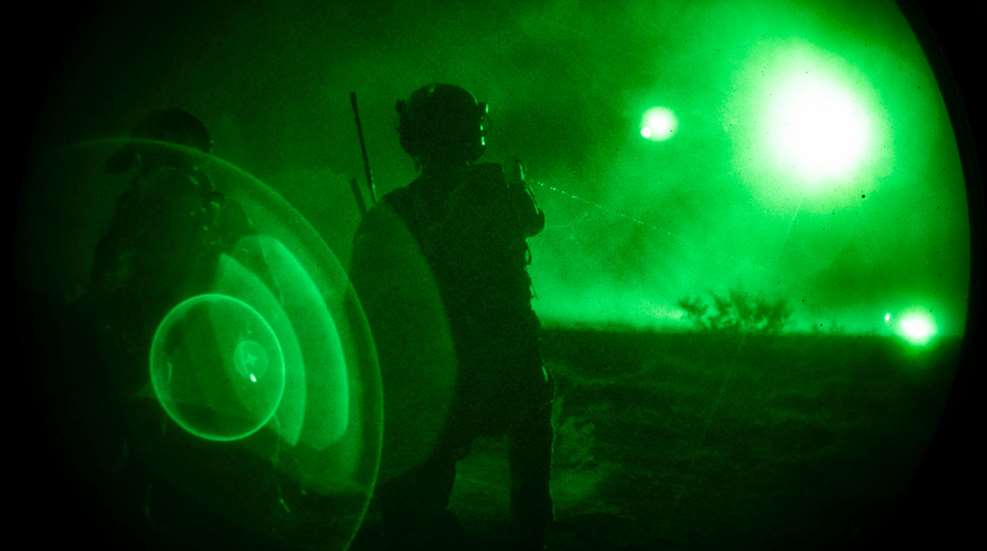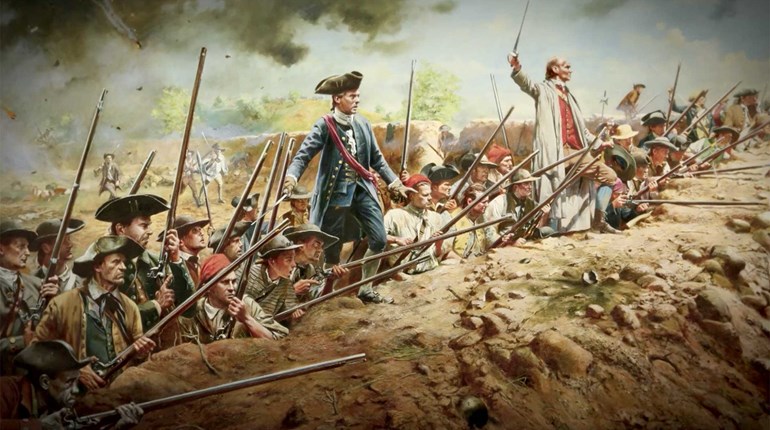
Using infrared technology can be challenging even with the best equipment, which is why the U.S. Army runs intricate training scenarios to familiarize its Soldiers with these IR devices.
When it comes to night shooting without the aid of a visible-light source, thermal and image-intensified (I²) night-vision riflescopes are the default solutions for several good reasons. Their form factors are similar to day optics and are therefore easy to adapt to. The best clip-on models have exceptional resolution and work in conjunction with existing day optics. Lower-cost, stand-alone units are still functional, even if they tend to lack the image quality and features of high-end I² and thermal scopes.
However, along with adding noticeable weight to our rifles, mounted night scopes all share a major Achilles’ heel: They limit situational awareness to whatever can be seen through their narrow fields-of-view (FOV). Unlike daytime riflescope users, the night shooter doesn’t have the luxury of looking over or alongside the optic to see a bigger picture. What you see through the night-vision device (NVD) is all you get. So, while they reign supreme for unidirectional engagements, they often fall short outside of static use—especially for solo hog/varmint hunters or home defenders.
Thankfully, there’s a pair of unsung night-shooting heroes that can pick up the slack: head-mounted I² goggles (or a monocular) and an IR aiming laser. Worn NVDs allow the rifle shooter to quickly see wherever he or she looks, and a zeroed laser allows quick, effective aiming without having to peer through a night scope and reposition a stabilized rifle. Therefore, when wide-area visibility or the need to deal with fast-moving game or threats is required, this dynamic duo provides an excellent solution for making hits in the dark.
Performance-wise, even older Gen 2 NVDs and Class 1 IR lasers allow minute-of-vitals accuracy out to at least 100 yards, and under starry skies often much farther. Goggles are easier to work with, but usually come at double the cost of an I² monocular. Wearing a monocular takes some getting used to, but they sometimes have the additional capability of being mounted to a rifle behind a day optic. Although this is an awkward setup (due to minimal eye relief), it can be useful on occasion. Regardless of NVD type, there are some tricks for setting up an IR laser to handle the aiming part of the equation.
A decade ago, I would only entrust my IR-laser-mounting needs to Picatinny rails that were integral to a metal receiver or handguard. However, I’ve found that when installed correctly, most aluminum M-Lok rail sections are solid enough to maintain the laser’s zero. I apply a mild thread-locking compound to the T-nuts, then torque them in accordance with manufacturers’ specifications and they stay tight for me.
When it comes to positioning a laser on the handguard, the vertical nature of gravity makes the 12- and 6-o’clock spots the simplest for managing the deviations from the line-of-laser (LOL) to the line-of-bore (LOB). Conversely, mounting on one side (or at an angle) adds an immediate windage component to gravity-induced elevation changes once the projectile passes through your LOL at the zero distance.
Placing the laser at the forward end of the handguard will reduce barrel and suppressor shadowing if an IR illuminator is also used. A remote-pressure switch adds more flexibility in positioning, but it’s another potential failure point. Conversely, using the support hand to activate the laser’s integral switch(es) is simpler, but less convenient.
When sighting in an IR laser, I use my NVD to look through the rifle’s day optic, then adjust the laser’s aiming point until it meets the day optic’s reticle at my desired-zero distance. Worn NVDs typically can see through non-magnified electro-optics (that have night-vision rheostat settings) and fixed-power scopes with etched reticles. Incident-ally, sighting through a non-magnified day optic, without a laser, is another effective way to hit the things you see with a worn NVD.
An NVD can sometimes be focused to see through an LPVO (set at 1X) or a low-power, fixed-magnification prismatic sight. Either one requires the NVD to stay a set distance from the scope’s objective so the target and reticle stay in focus. This zeroing technique will be much easier if a helper adjusts the laser while you aim the rifle and call out corrections.
While these methods should get you on paper, the laser’s zero must still be tweaked to ensure that you are hitting exactly where the IR spot meets the target. Once zeroed, the day optic is ignored, allowing the rifle to be fired from a wide variety of positions, so long as it’s stable.
If your day sights aren’t compatible with your NVD, move to within about 15 yards of the target in order to get the laser on paper, then make periodic adjustments as you move back to your desired zero distance for fine-tuning. Keep in mind that because the LOL is straight, while projectiles drop and drift over distance, it’s important to practice at different ranges. Knowing where your projectile is relative to the laser will help determine your holdovers and limitations.
Seeing a flat, paper target through NVDs can be challenging on moonless, cloudy, dusty, foggy or rainy nights. Using a light-colored target against a dark background helps, as does a small piece of IR-reflective tape on the target’s intended point-of-aim. An IR floodlight is also useful, especially if independently controlled. When the IR flood and laser are on the same switch, dust, humidity or combustion gasses can reflect the flood’s beam, making it difficult to aim or observe in less-than-clear air.
Having a partner on hand is good practice when night shooting. In addition to helping with laser adjustments, he or she can assist with target identification and watch for hazards that are outside your area of focus. When zeroing in light conditions that are too poor to allow a clear I² target image, a small, dim, visible-light source near the target will help.
Finally, you should assume that even criminals and terrorists have night-vision gear these days. Therefore, treat IR floods and lasers the same as you would a visible weaponlight: The less they are on, the less chance you’ll turn yourself into an easy target for someone else if you’re forced into a defensive-shooting situation at night.






































